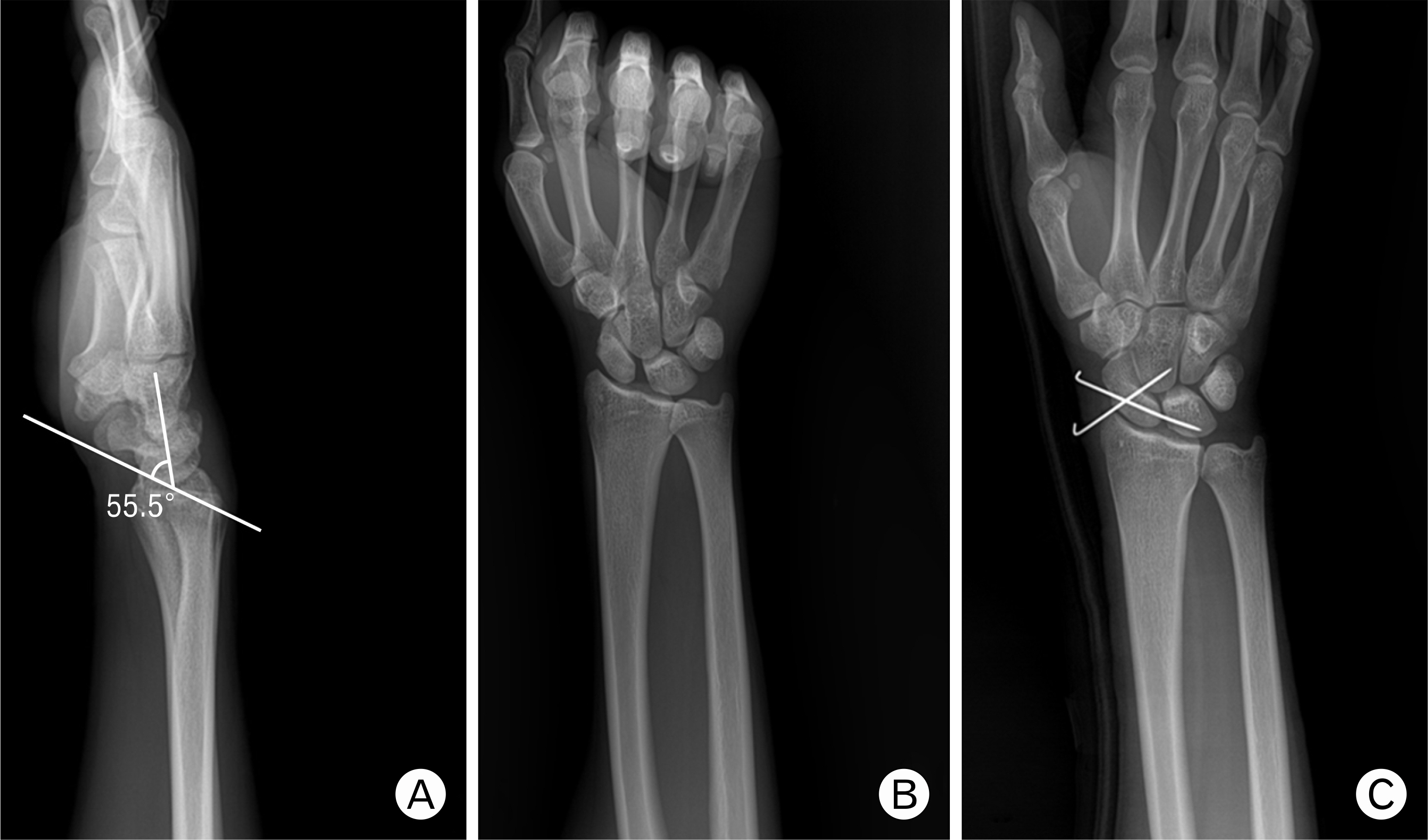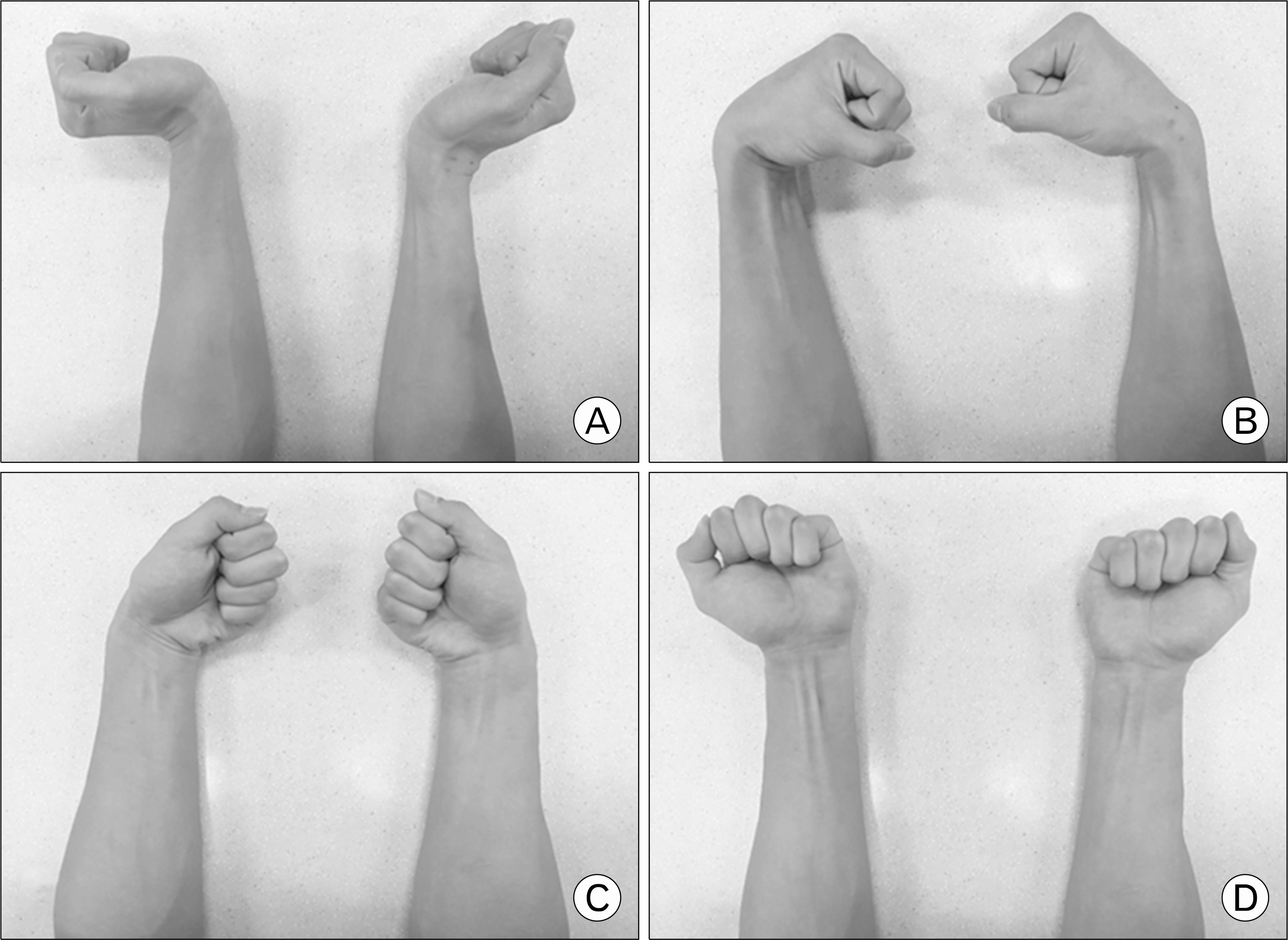Korean J Sports Med.
2019 Sep;37(3):101-106. 10.5763/kjsm.2019.37.3.101.
Wrist Rehabilitation after Scapholunate Interosseous Ligament Reconstruction for a Collegiate Basketball Player
- Affiliations
-
- 1Department of Sports Medicine, Kyung Hee University, Yongin, Korea. daeho.kim@khu.ac.kr
- KMID: 2456197
- DOI: http://doi.org/10.5763/kjsm.2019.37.3.101
Abstract
- For a basketball player who had scapholunate interosseous ligament injury related to sport, it is crucial to secure the active range of motion (ROM) and regain proprioception of the wrist. The player was involved in a 21-week rehabilitation procedure based on controlling pain with inactive treatments, restoring the wrist ROM with active treatments. We measured the visual analog scale (VAS) for pain, upper extremity functional outcome measurement (Disabilities of Arm, Shoulder, and Hand [DASH]) for the functionality, and active ROMs of the wrist. The VAS was decreased (after surgical treatment, 8.7; 1 week, 2.5; 12 week, 3-5; 21 week, 0). The DASH score was decreased when he returned to play (after surgical treatment, 78; end of the rehabilitation, 23). Wrist flexion and extension ROM were increased to 55° and 67°, respectively. To restore the function of the wrist for basketball performance, improvement of active ROM and proprioception is the primary goal to return to play.
Keyword
MeSH Terms
Figure
Reference
-
References
1. Zuckerman SL, Wegner AM, Roos KG, Djoko A, Dompier TP, Kerr ZY. Injuries sustained in National Collegiate Athletic Association men's and women's basketball, 2009/2010–2014/2015. Br J Sports Med. 2018; 52:261–8.
Article2. Mugnai R, Della Rosa N, Tarallo L. Scapholunate interosseous ligament injury in professional volleyball players. Hand Surg Rehabil. 2016; 35:341–7.
Article3. Johnson BK, Brou L, Fields SK, Erkenbeck AN, Comstock RD. Hand and wrist injuries among US high school athletes: 2005/06–2015/16. Pediatrics. 2017; 140:e20171255.
Article4. Farana R, Jandacka D, Uchytil J, Zahradnik D, Irwin G. The influence of hand positions on biomechanical injury risk factors at the wrist joint during the round-off skills in female gymnastics. J Sports Sci. 2017; 35:124–9.
Article5. Frankel VH. The Terry-Thomas sign. Clin Orthop Relat Res. 1977; 129:321–2.
Article6. Kim JH, Lee HS, Park SW. Effects of the active release technique on pain and range of motion of patients with chronic neck pain. J Phys Ther Sci. 2015; 27:2461–4.
Article7. Maeda T, Yoshida H, Sasaki T, Oda A. Does transcutaneous electrical nerve stimulation (TENS) simultaneously combined with local heat and cold applications enhance pain relief compared with TENS alone in patients with knee osteoarthritis? J Phys Ther Sci. 2017; 29:1860–4.
Article8. Axelson HW, Hagbarth KE. Human motor control consequences of thixotropic changes in muscular short-range stiffness. J Physiol. 2001; 535(Pt 1):279–88.
Article9. Kage V, Ratnam R. Immediate effect of active release technique versus mulligan bent leg raise in subjects with hamstring tightness: a randomized clinical trial. Int J Physiother Res. 2014; 2:301–4.10. Do K, Kim J, Yim J. Acute effect of self-myofascial release using a foam roller on the plantar fascia on hamstring and lumbar spine superficial back line flexibility. Phys Ther Rehabil Sci. 2018; 7:35–40.
Article11. Wolff AL, Wolfe SW. Rehabilitation for scapholunate injury: application of scientific and clinical evidence to practice. J Hand Ther. 2016; 29:146–53.12. Hagert E, Garcia-Elias M, Forsgren S, Ljung BO. Immunohistochemical analysis of wrist ligament innervation in relation to their structural composition. J Hand Surg Am. 2007; 32:30–6.
Article13. Karagiannopoulos C, Sitler M, Michlovitz S, Tucker C, Tierney R. Responsiveness of the active wrist joint position sense test after distal radius fracture intervention. J Hand Ther. 2016; 29:474–82.
Article14. Salles JI, Velasques B, Cossich V, et al. Strength training and shoulder proprioception. J Athl Train. 2015; 50:277–80.
Article
- Full Text Links
- Actions
-
Cited
- CITED
-
- Close
- Share
- Similar articles
-
- Comparison of Midcarpal versus Radiocarpal Arthroscopy of Interosseous Ligament Injuries in the Wrist
- Surgical Treatment of Scapholunate Instability
- Biomechanical Analysis of Three Different Reconstruction Techniques for Scapholunate Instability: A Cadaveric Study
- Scapholunate Dissociation: Current Concepts of the Treatments
- Diagnosis and Management of Ligament Injuries of the Wrist




